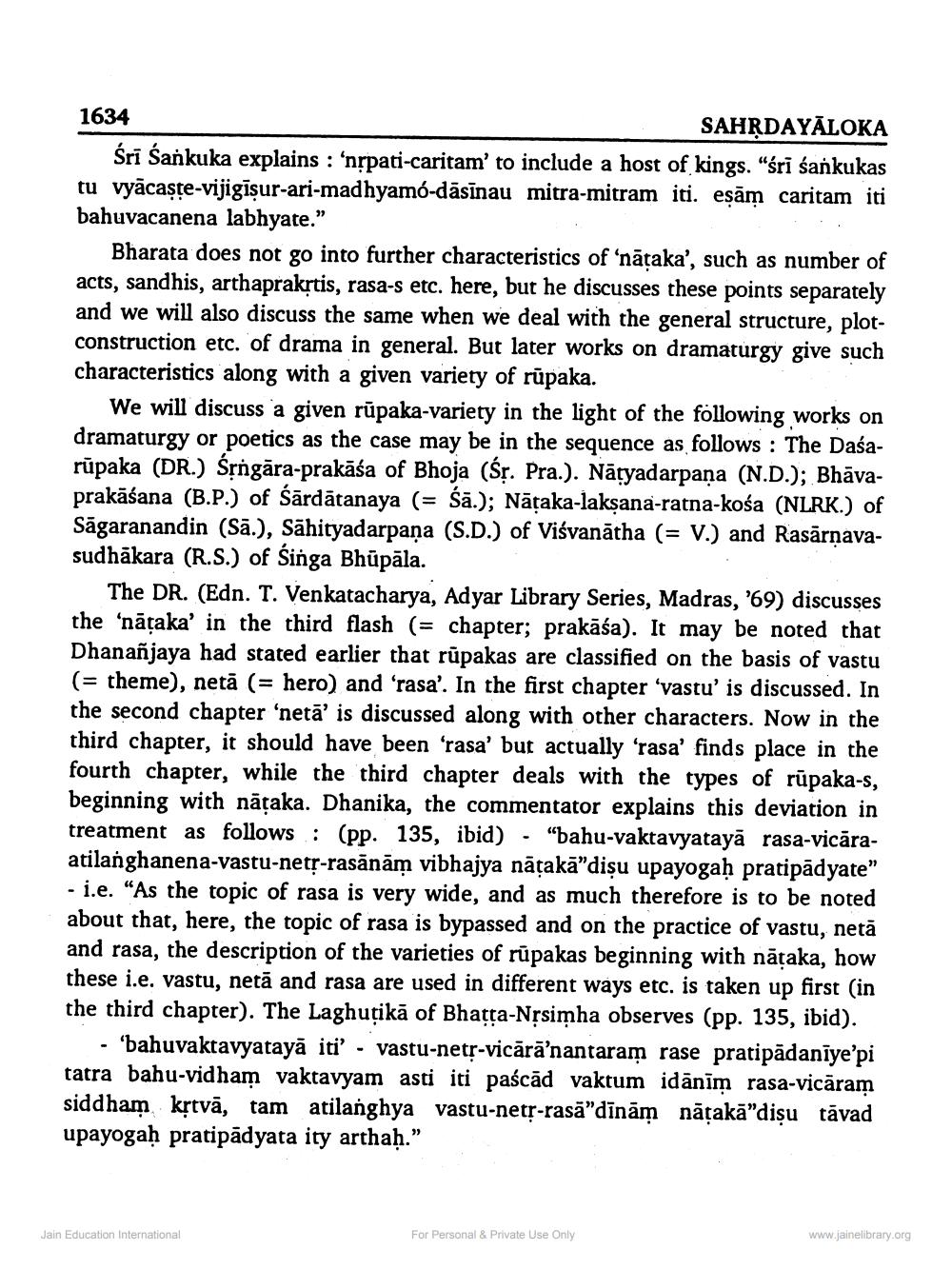________________
1634
SAHRDAYĀLOKA
Sri Sankuka explains : 'nrpati-caritam' to include a host of kings. "śri sankukas tu vyācaște-vijigīşur-ari-madhyamó-dāsīnau mitra-mitram iti. eșām caritam iti bahuvacanena labhyate."
Bharata does not go into further characteristics of 'nāțaka', such as number of acts, sandhis, arthaprakrtis, rasa-s etc. here, but he discusses these points separately and we will also discuss the same when we deal with the general structure, plotconstruction etc. of drama in general. But later works on dramaturgy give such characteristics along with a given variety of rūpaka.
We will discuss a given rūpaka-variety in the light of the following works on dramaturgy or poetics as the case may be in the sequence as follows : The Daśarūpaka (DR.) Śrngāra-prakāśa of Bhoja (śr. Pra.). Nāryadarpana (N.D.); Bhāvaprakāśana (B.P.) of śārdātanaya (= Śā.); Nātaka-laksana-ratna-kośa (NLRK.) of Sāgaranandin (Sā.), Sāhityadarpaņa (S.D.) of Viśvanātha (= V.) and Rasārņavasudhākara (R.S.) of singa Bhūpāla.
The DR. (Edn. T. Venkatacharya, Adyar Library Series, Madras, '69) discusses the ‘nāțaka' in the third flash (= chapter; prakāśa). It may be noted that Dhananjaya had stated earlier that rūpakas are classified on the basis of vastu (= theme), netā (= hero) and 'rasa'. In the first chapter 'vastu' is discussed. In the second chapter 'netā' is discussed along with other characters. Now in the third chapter, it should have been 'rasa' but actually 'rasa' finds place in the fourth chapter, while the third chapter deals with the types of rūpaka-s, beginning with nātaka. Dhanika, the commentator explains this deviation in treatment as follows: (pp. 135, ibid) · "bahu-vaktavyatayā rasa-vicāraatilanghanena-vastu-netr-rasānām vibhajya nātakā"dişu upayogaḥ pratipadyate" - i.e. "As the topic of rasa is very wide, and as much therefore is to be noted about that, here, the topic of rasa is bypassed and on the practice of vastu, netā and rasa, the description of the varieties of rūpakas beginning with nătaka, how these i.e. vastu, netā and rasa are used in different ways etc. is taken up first (in the third chapter). The Laghuţikā of Bhatta-Nșsimha observes (pp. 135, ibid).
- bahuvaktavyatayā iti' . vastu-netr-vicārā'nantaram rase pratipādanīye'pi tatra bahu-vidham vaktavyam asti iti pascad vaktum idānim rasa-vicāram siddham kṛtvā, tam atilanghya vastu-nett-rasā”dīnām nāțakā"dişu tāvad upayogaḥ pratipādyata ity arthaḥ.”
Jain Education International
For Personal & Private Use Only
www.jainelibrary.org




